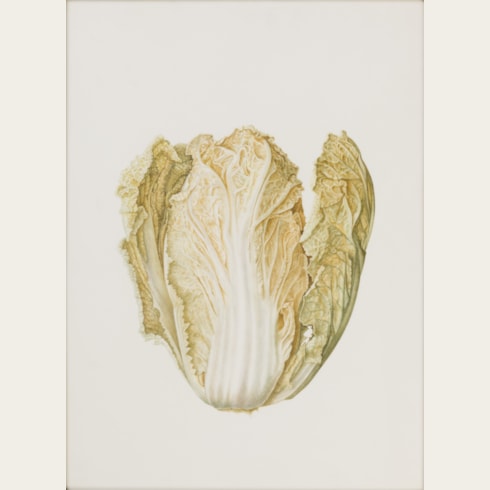Brigid EDWARDS
(London 1940)
Ridge Gourds, Bitter Gourd
Watercolour, over an underdrawing in pencil, on vellum.
381 x 305 mm. (15 x 12 in.)
381 x 305 mm. (15 x 12 in.)
Like many botanical artists, Brigid Edwards works very slowly. As she has stated, ‘A large painting (and I mean volume and painted area as opposed to large but unpainted surface) can take up to twelve weeks to complete.’ Edwards almost always paints her watercolours on smooth, prepared vellum. As she recounts of her working methods, ‘I get my vellum from William Cowley Parchment and Vellum Works who also mount and stretch the skins on board to my specific dimensions. A white gesso ground is applied which smoothes the surface but inevitably because it is a natural skin there remains an irregularity of texture and pigment. In the past I have made my own boards but it is very time-consuming and expensive if things go wrong…So far there have been no problems with splitting or cracking. I think I decided to “anchor” them because I found the wavy edges rather distracting…I use Winsor & Newton or Rowney & Schminke watercolours, depending on pigment. I choose vellum rather than paper because I have always found paper too absorbent and difficult to rectify. I use ophthalmic surgical blades to remove paint from vellum where necessary.’
The present sheet was drawn in 2016, and depicts two ridge gourds at the left and a single bitter gourd at the right. Resembling a cucumber or zucchini with ridges, the ridge gourd (Luffa acutangula) is found throughout Asia. When unripe, its fruit is cultivated and eaten as a vegetable, particularly in China, India, and Vietnam, while when fully matured it can be harvested, dried and made into natural cleaning sponges or body scrubs. The bitter gourd (Momordica charantia), more commonly known as a bitter melon, is a tropical and subtropical vine grown throughout Asia, Africa and the Caribbean for its edible fruit, as well as for medicinal purposes. Of the several varieties of bitter gourd that are known, the fruit depicted in this drawing appears to be an Indian cultivar. Cooked when it is green or beginning to turn yellow, the bitter gourd is used extensively in the cuisine of the Indian subcontinent.
The present sheet was drawn in 2016, and depicts two ridge gourds at the left and a single bitter gourd at the right. Resembling a cucumber or zucchini with ridges, the ridge gourd (Luffa acutangula) is found throughout Asia. When unripe, its fruit is cultivated and eaten as a vegetable, particularly in China, India, and Vietnam, while when fully matured it can be harvested, dried and made into natural cleaning sponges or body scrubs. The bitter gourd (Momordica charantia), more commonly known as a bitter melon, is a tropical and subtropical vine grown throughout Asia, Africa and the Caribbean for its edible fruit, as well as for medicinal purposes. Of the several varieties of bitter gourd that are known, the fruit depicted in this drawing appears to be an Indian cultivar. Cooked when it is green or beginning to turn yellow, the bitter gourd is used extensively in the cuisine of the Indian subcontinent.
Born in London, the botanical artist Brigid Segrave Edwards studied illustration and graphic design at the Central School of Art in London and enjoyed a successful career as a television producer and director before turning to botanical illustration in the mid-1980s. She first exhibited her work at the Summer Exhibition of the Royal Academy in 1990 – an unusual honour for a botanical artist - and has also had her work shown at the Linnean Society in London, the Hunt Institute for Botanical Documentation in Pittsburgh and the Kew Gardens Gallery, as well as at commercial galleries in London and New York. Early in her career as a botanical artist, Edwards was commissioned to paint 115 watercolours of species of primulas from life as illustrations for the book Primula by John Richards, published in 1993; the watercolours for the project were later exhibited at Kew Gardens. Edwards has won a number of gold medals for botanical illustration from the Royal Horticultural Society, and in 2005 her work was included in the exhibition A New Flowering: 1000 Years of Botanical Art at the Ashmolean Museum in Oxford. She also paints watercolours of insects (some of which were exhibited at the Smithsonian Institution in Washington, D.C. in 2003) and takes black and white photographs of plant forms. In 2018 Edwards was commissioned to design a postage stamp as part of a series featuring endangered species for the United Nations, and also designed the cover for the novel El ala izquierda (The Left Wing) by the Romanian writer Mircea Cartarescu. She lives and works in the town of St. Just in Cornwall. Watercolours by Edwards are today in the Hunt Institute for Botanical Documentation in Pittsburgh, the Royal Botanic Gardens at Kew and the Shirley Sherwood Collection of contemporary botanical art.











